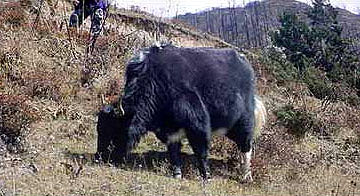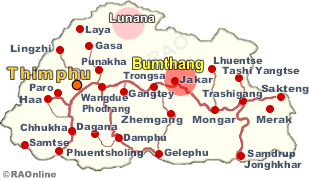 |
Bhutan's
Economy: Yak Farming |
|
 |
Bhutan's
Economy |
|
|
 |
 
|
"Water
poisoning" kill Yaks in Bumthang: |
 |
Yak
Every
year on December, Bumthang's estimated 5,000 yaks are beginning the descent
over 1,000 metres to the winter grazing grounds in the lower valleys. Educating
Yak herders is one of the preventive measures against "chuh dug" But some
of the animals will not complete the journey, having fallen prey to what
is known as chuh dug or "water poisoning". |
Last
winter at least a dozen yaks died of chhu dug in the dzongkhag which, according
to the regional veterinary laboratory (RVL) in Bumthang, is considered
more fatal and has a higher mortality rate than other livestock diseases,
including the foot and mouth disease (FMD). An team of experts has visited
upper Chokortoe to tell yak herders to take necessary precautions. The
team has also visited Ura and Chumey.
|
Poisoning
caused by a toxic algae |
 |
An
expert said that the poisoning was caused by a toxic algae called cyanobacteria,
present in stagnant water. During migration to the lower valleys, water
becomes scarce and yaks invariably drink from stagnant lakes, ponds, streams,
and marshy areas where the poisonous blue-green algae blooms. The poison
emitting condition of the algae is usually triggered by the first frost.
The toxic compounds released by the algae affects the nerves and liver
and the animal suffers from paraplegia (paralysis of hindquarters), abortion
in pregnant animals, dehydration, diarrhea, and ultimately death. |
"Ninety
percent of the yaks that drink the poisonous water die," the expert said.
Researchers at RVL are of the opinion that the poisonous algae probably
lives at an altitude between 2,800 metres to 3,000 metres. Researchers
said that, while the toxic agent had been identified, there was no past
literature on treatment and prevention measures as there was no record
of the disease in other yak countries.
Affected
yaks are treated with antitoxins, a mixture of certain non-patent drugs,
antibiotics and vitamins as part of a preliminary treatment regime, based
on symptoms, established by the RVEC. As preventive measures veterinarians
are also educating the yak herders on management of yak husbandry, avoiding
and fencing doubtful drinking grounds and providing an alternative clean
drinking source.
| Yaks
also die from the Gid disease and plant poisoning |
The
Gid disease is communicated to the yak through the excreta of dogs. It
is a kind of tape worm that grows into a cyst (Coenurus Cerebralis) either
in the brain or the spinal cord of the yak. Deworming and sterilising yak
dogs and burning or burying the heads of Yaks that succumb to the disease
are some of the preventive methods that have been initiated. Research in
Merak found that there were about five known poisonous plants causing the
premature death of the yak. These plants contained toxic PyrosIlizidine
Alkaloid which 'affects the liver causing slow death. The yak consumed
these plants for lack of any other vegetation during the severe winter
months
A
decade ago Soiyaksa yak herders sold as much butter as they produced to
farmers in the lower valleys. Today, however, the once sought-after yak
butter has lost its grip over its main customers in Paro valley. Yak herders
find it extremely difficult selling the butter even when they go door to
door to farmers' houses. "In the past they bartered butter for red rice
now the herders find it difficult even to barter for the ordinary white
rice," the pasture inspector of the dzongkhag livestock sector, Nidup Tshering,
told.
top
| Poisoning
by plants or contaminated water |
Poisoning
by plants or contaminated water (locally termed as baduk and chuduk) is
another major cause of mortality, especially in the central region (Dahl,
2000). Such disease conditions occur at the end of winter to onset of spring
season when grazing resources are in short supply. Animals consume plants,
such as Senecio species, which they normally avoid when other pastures
are
available. The Senecio species is found to contain Pyrrolizidine alkaloid,
a highly toxic chemical (Winter et al., 1994)
| Contributed
by
KUENSEL, Bhutan's National Newspaper |
 |
top
|
more
information
|

|
|




